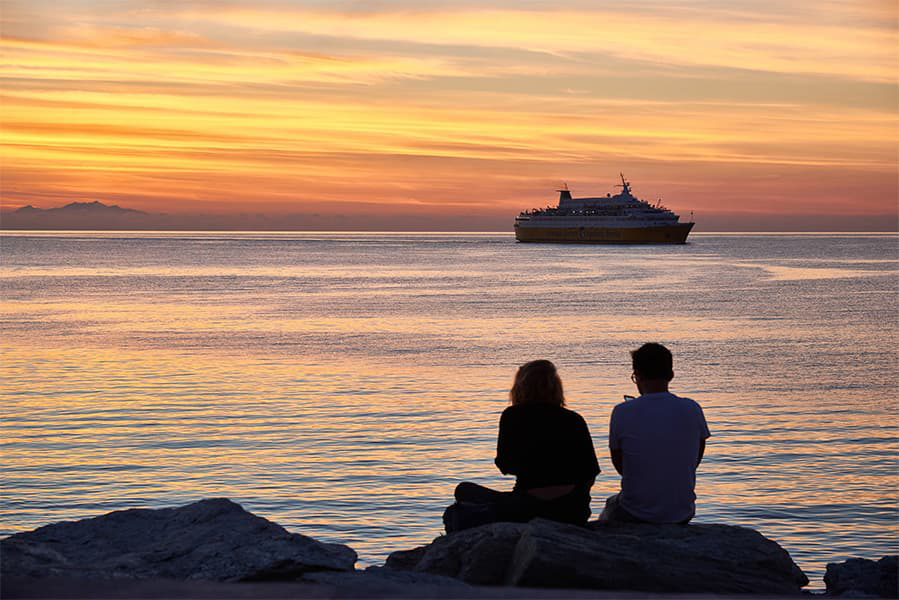Naples – Amalfi
Ferries to Italy
Naples – Amalfi
Ferries to Italy

Depending on the season their are usually 5 daily and 32 weekly sailings between Naples and Amalfi. 2 ferry operators provide the ferries from Naples to Amalfi, NLG & Positano Jet.Naples Amalfi ferries take around 2 hours 10 minutes. The ferry costs between $100 and $360, depending on ticket details. Prices exclude any service fees. Ferry timetables change seasonally, use our Deal Finder to get live pricing and availability for ferries from Naples to Amalfi.
The earliest Naples Amalfi ferry typically departs Naples at about 08:35 and the last ferry usually leaves at 15:35.
Ferries from Naples to Amalfi sail in around 2 hours 10 minutes. The fastest ferry is approximately 1 hour 55 minutes. Ferry duration can vary by ferry provider and can be impacted by weather conditions.
There is 32 weekly sailings from Naples to Amalfi provided by NLG & Positano Jet. Timetables can change from season to season.
NLG provide 25 sailings weekly. Positano Jet provide 7 sailings weekly.
The price of a ferry from Naples to Amalfi typically range between $100* and $360*. On average the Naples Amalfi ferry is $199*. The cheapest Naples Amalfi ferry prices start from $100*. The average price for a foot passenger is $199*.
Pricing will vary depending on number of passengers, vehicle type, route and sailing times. Pricing is taken from searches over last 30 days and exclusive of service fees, last updated April 25.
The distance between Naples to Amalfi is approximately 28 miles (44km) or 24 nautical miles.
Yes, Naples Amalfi ferries allow cars onboard with NLG & Positano Jet between Naples and Amalfi. To view car ferry tickets and prices between Naples and Amalfi use our Deal Finder.
NLG & Positano Jet allow foot passengers on Naples Amalfi ferries.
Currently, are not permitted to board ferries from Naples to Amalfi.
More routes than anyone else.

Compare fares, times & routes in one place.
Change plans easily with flexi tickets.

Book e-tickets & manage trips in-app.
Live ship tracking & real-time updates.

Top-rated customer support when you need it.
| Naples - Amalfi Route summary | ||
|---|---|---|
| Departure Country | Italy | |
| Destination Country | Italy | |
| No. of Operators | 1 | |
| Operators | NLG | |
| Average Price | A$208* | |
| Average Weekly Sailings | 3 | |
| Average Sailing Duration | 2h 8m | |
| Fastest Sailing Duration | 2h 0m | |
| First Ferry | 08:35 | |
| Last Ferry | 15:35 | |
| Distance | 23 nautical miles | |
* Prices subject to change, pricing is taken from last 30 days, last updated 2024-11-05.
The Italian city of Naples, or Napoli as it is also called, is located in the Campania region of the country and lies on the Gulf of Naples, on southern Italy's west coast. The city is located in an enviable position between two volcanic areas, Mount Vesuvius and the Campi Flegrei. The Roman ruins of Pompeii, Herculaneum, Oplontis and Stabiae, which were destroyed the eruption of Vesuvius in 79 AD, are located close to the city as is the city of Sorrento and the beautiful Amalfi Coast. Also located close to Naples are the former parts of the Roman naval facility of Portus Julius, namely the port towns of Pozzuoli and Baia which are both to the north of Naples. The city is adorned with medieval, Baroque and Renaissance churches, castles and palaces and has long been an important centre for the arts and architecture. In the 18th century, Naples went through a period of neoclassicism, following the discovery of the remarkably intact Roman ruins of Herculaneum and Pompeii.
The port of Naples is home to several ferry, hydrofoil and SWATH (Small Waterplane Area Twin Hull) catamaran services, linking numerous locations in both the Neapolitan province, including Capri, Ischia and Sorrento, and the Salernitan province, including Salerno, Positano and Amalfi. Ferry services also operate to Sicily, Sardinia, Ponza and the Aeolian Islands.
The Italian town of Amalfi is the largest town located along the Amalfi Coast which is in the Province of Solerno. The town lies on the shores of the Gulf of Solerno and at the base of Monte Cerreto. Along with many other towns along the Amalfi Coast such as Ravello and Positano, Amalfi has been declared a UNESCO World Heritage Site. The town's written history dates back to the 6th century AD and soon after became an important maritime power by trading grain from its neighbours, slaves from the interior, salt from Sardinia and timber, in exchange for gold dinars minted in Egypt and Syria. This trade was carried out in order to purchase Byzantine silks that it then sold on to the West.
The town is used to looking after its visitors with several former monasteries having being converted into hotels. The Luna Convento was converted in the beginning of the 19th century and the Cappuccini Convento was converted in the 1880's. Celebrated visitors to Amalfi included the composer Richard Wagner and the playwright Henrik Ibsen, who both completed works whilst staying in Amalfi.
Seasonal hydrofoil routes connect the resorts on the Sorrentine and Amalfi coasts as well as Pozzuoli, Ischia, Procida, Naples, Torre Annunziata (for Pompeii), Ercolano (for Herculaneum), Capri, Salerno, Agropoli (for Paestum) and Palinuro on the Cilento Coast.